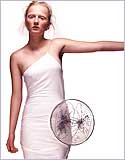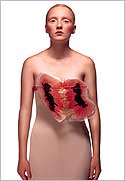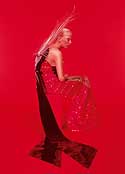| |
 |
| Sperm cage |
 |
| Double DNA dress |
 |
| Anaphase dress |
 |
| Implantation dress |
 |
| Primitive Streak dress |
 |
| Neural induction dress |
 |
| Closing neural tube dress |
 |
| Heart tube hat |
 |
| Heart tubes and diaphragm descending dress |
 |
| Nerve net dress |
 |
| Spinal column dress |
|
Introduction
Between fertilisation and the appearance of the recognisable human form a single cell (the fertilised egg) divides many times to produce millions of cells. Unchecked cell proliferation leads to cancer, but the regulation of cell production and differentiation during embryonic development ensures that the right kind of cells form in the right place at the right time. Exactly how this happens is one of the most important questions in biology today.
Fertilisation. 0 - 1.5 days
Designs 1-5. A sperm digests its way into the egg and genes from the male and female meet. Entry of a single sperm triggers events that stop other sperm penetrating the egg. Development begins.
Design 1. 1000 sperm coat. The coat was made by two students simultaneously over a period of 105 hours. It was first embroidered with nylon threads onto dissolvable fabric and then over embroidered again with cream and white threads leaving the tails free. The coat was then left to soak in a bath of cool water. The backing cloth fell away leaving the fabric as shown.
Design 2. Sperm cage. Made by the jewellers Erickson Beamon the cage represents the fertilised egg. The form is made of knitted nylon thread laced onto plastic heat shaped tubes. The sperm heads are made of crystal and the sperm tails out of silver watch chains.
Design 3. Sperm internal structure dress. The bodice of the dress is made out of fibreglass and the graphic representation of the sperms internal structure is hand painted in oils. The nucleus of the sperm is in black and the red band represents the enzymes released to digest a way into the egg. The silver coil belt symbolises the mitochondria, the powerhouse of this highly mobile cell.
Design 4. Double sperm dress. The skirt part of the dress is made in the high spun viscose jersey and the sperm shaped breast plates have been vacuum formed in perspex and sprayed from underneath. The tails are made from 100% silk chiffon.
Design 5. Fertilised egg. The bodice of the dress is made from sponge, printed and over embroidered with cream white and black threads. The top halves are mirrored to reflect back the image of the woman wearing it. The skirt is made in high spun viscose jersey. The bodice is held together by the head of a single penetrating sperm.
|
Cell division. 1.5 – 4 days
Designs 6-11. The first division of the fertilised egg generates two cells each of which receives identical genetic information. Nuclei from the sperm and egg fuse and their chromosomes are duplicated. Matching pairs of chromosomes (see design 11) line up along the midline of the cell and are separated as the cell divides.
Design 6. Calendar dress. Aluminium hoops support three panels of embroidered silk chiffon to show how cells multiply. The first layer depicts a single cell, the second one (beneath) is at the point of first cell division and the third layer represents the four cell stage. The under dress is made of high spun viscose.
Design 7. Chromosome kimono. The kimono jacket is made from 100% silk and is discharge printed with red chromosomes. The jacket is lined with sponge. The skirt is made of 100% silk jersey and the tail of it is bound in silver chain mail.
Design 8. Double DNA dress. This double dress is made of high spun viscose and lined in 100% silk. The lining has been bias cut (on the cross) and printed with a DNA sequence. The sequence spirals within the outer dress, a reminder of the helix formation of DNA. The embroidery on silk organza is stretched across a hoop and inserted in between the two dresses. The thread work captures the nature of cells pulling apart.
Design 9. Eight cell stage. Inserted into this high spun viscose dress are two circular panels of bias cut silk chiffon. The embroidered panel shows the eight cell stage. Each of the eight cells is still capable of forming a complete embryo.
Design 10. Chromosome patterning dress. This dress is made from 100% black silk which has been splash sprayed with acid to bleach out the colour and over printed with red flock to show an example of chromosomic patterning. The dress is bias cut and suspended from an aluminium hooped frame.
Design 11. Anaphase dress. The breast plate front of this dress shows pairs of chromosomes pulling apart. It has been suspended floating ahead of the dress and is deliberately meant to quiver when worn, mimicking the shudder of cells as they divide. The back of the breast plate is bonded with plastic mirror to throw some light back onto the wearer. The red fringing across the front is a reminder of the spindles along which the chromosomes are drawn. The bottom of the dress is made from tea coloured high spun viscose.
|
Implantation. 5 – 11 days
Design 12. The egg divides many times to produce a ball of cells. Cells on the outside will form the placenta while the inner cell mass with make the body. At five days the embryo implants in the womb.
Design 12. Implantation dress. The implantation dress is made out of red silk jersey and 100% silk chiffon. The red part of the dress has been embroidered to show the embryo implanting into the uterus wall (black).
|
Primitive Streak and the Mesoderm formation. 12 – 14 days
Design 13. Within the implanted embryo the inner cells from a two layered disc. The top layer of cells moves towards the future tail end of the embryo and forms a unique structure, the Primitive Streak. This then extends towards the future head of the embryo. The movement of cells through the Primitive Streak generates an important new layer of cells called the mesoderm. These cells will give rise to major structures of the body such as muscles, bone, kidney and the heart.
Design 13. Primitive Streak dress (African Streak) The Primitive Streak is represented by two sheets of metallic silver cloth which fold back upon themselves along the length of the dress. The new layer of cells, the mesoderm is indicated by a sheet of gold metallic fabric which emerges from beneath the silver folds of the Primitive Streak. The top part of the Primitive Streak is represented by two layers of black plastic. The dress supporting this structure is made from a hand printed fabric from central Africa.
|
Neural Induction. 15 -18 days
Design 14. Cells at the top of the streak produce chemical signals (represented by the fibre optics) which induce the fan shaped neural plate. This is the beginning of the nervous system.
Design 14. Neural induction dress (Indian Streak). 8,000 fibre optic endings have been sealed into a light source of 1 inch circumference. These fibres have been divided up and cut randomly along their length to suggest the spread of signals from the top of the Primitive Streak. The dress itself is made from an Indian sari and the Primitive Streak and node at the back of the dress are represented in black plastic.
Design 15. Afghan streak. The under dress is made in 100% silk chiffon and has been splashed with acid to suggest cell movement. The black plastic Primitive Streak has shifted downwards and tissues that have emerged include the prechordal plate (seen here as a collar). The tasselling of this ancient Afghan wedding tent evokes the emergence of the first segmented structures in the embryo.
|
Neurulation/Segmentation. 22 – 25 days
Designs 16-17. The flat neural plate rolls up to form the neural tube which will become the brain and spinal cord. The developing spinal cord is flanked by regular structures called somites, the first segmented structures to appear in the embryo. These structures will contribute to the muscles and vertebrae of the back bone.
Design 16. Neural fold dress. This dress is made out of white fake fur. The shaping on the front is abstract but the formations on the back depict the rolling up of the neural plate to form the neural tube. The developing somites are shaved into the fur flanking the neural tube.
Design 17. Closing neural tube dress. Made out of red fake fur this dress shows (on the back) the progression of somite formation and the continued closure of the neural tube.
|
Heart Development. 20 - 21 days
Designs 18-21. The heart forms from two primitive blood vessels which arise above the developing brain. The primitive blood vessels fuse to form a single heart tube as they descend into the future chest cavity.
Design 18. Heart tube hat. Helen and Kate decided that in this instance a hat would better explain the development of the heart than a dress so asked the milliner Philip Treacy to come up with a design. His finished piece shows the two blood vessels coming together and the developing diaphragm beneath.
Design 19. Heart tubes and diaphragm descending dress. This dress is made in two parts. The under dress of high spun viscose jersey and an over layer made in 100% black silk chiffon. The black gauze stretched across the front of the chiffon over dress represents the descending diaphragm upon which the fusing blood vessels will eventually rest.
Design 20. Heart tubes fusing bodice and skirt. The bodice of this outfit has been made like the hat, by pulling fabric over a wooden block shaped to the contours of the developing heart. In this outfit the diaphragm has descended further and the heart tubes have begun to fuse. The skirt is made of 100% red silk chiffon.
Design 21. Heart bird. The heart bird was created to illustrate the fully folded heart tube. It is balanced by a feather tail. The heart itself has been made in the same way as above and is held in shape from the inside by fine nylon wires.
|
Limb Formation. 26 – 29 days
Design 22. Limb buds which will form the arms and legs, arise at two distinct levels along the flanks of the embryo. Arm buds appear first and the forming digits are visible from day 37.
Design 22. Limb bud dress. This dress is made out of artist’s primed canvas, painted by Chloe Sendall in oils.
Cell specialisation. 30 - 40 days
Designs 23-27. Nerve cells put out long fine processes that contact and signal to distant cells. By day 32 spinal nerves begin to sprout. By day 35 regional subdivisions of the nervous system arise such as the cerebellum and by day 42 the skeleton is laid down as ossification of developing bones begins.
Design 23. Nerve net dress. This double dress in silk and viscose jersey has been printed with acid to burn out the natural fibre leaving the patterning of a retinal neuron. The twig incorporated into the dress is symbolic of the many arborizations characteristic of nerve cells. The hem of this dress has been blasted with high frequency ultra sound which has simultaneously cut and sealed the fibres.
Design 24. Fibre optic nerve net dress. This dress is made out of black high spun viscose. The nerve net cell structure has been hand embroidered and woven with 200 fibre optic ends to symbolise signals passing along the nerve cell.
Design 25. White nerve net dress. This dress is made with a cloth of viscose and silk. The viscose has been burnt away with acid to leave the shape of a neuron. 200 fibre optic ends have been used to light the dress and evoke the passing of electrical impulses through networks of nerves.
Design 26. Spinal column dress. The fabric used here is 100% silk and has been printed by Coats Viyella Plc. Using a DNA sequence run from a laboratory gel the patterning here is used to recall the molecular basis of embryonic development. This female spine has been cast in resin and hand plated with aluminium foil. 8,000 fibre optic endings have been sealed into a 1 inch light source and fed through the spine at irregular intervals. These fibres represent the nerve processes that extend throughout the body.
Design 27. Rib cage dress. The rib cage has been cast in resin and hand plated in aluminium. The fabric has been printed by Coats Viyella Plc using an enlarged DNA sequence as above.
Primitive streak photographs by Justine, model Korinna at Models 1 |











